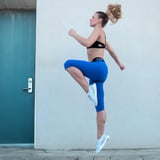

Whatever your goals for your workouts - whether to lose weight, build endurance, or sculpt lean muscle - tracking your heart rate can help ensure that they're as effective as possible. "Heart rate is a good indicator of two things: your overall cardiovascular fitness and how hard you're working," Corey Phelps, an NASM-certified personal trainer and creator of Cultivate365, an online fitness and mental health platform for women, told POPSUGAR.
To use it to your advantage, you first have to calculate your maximum heart rate - that's the maximum number of times your heart should beat per minute during exercise - by subtracting your age from 220. Then you'll take a percentage of that number, which varies based on the workout, and that will become your target heart rate zone.
"One of these zones is the fat-burning zone, which is achieved at a lower heart rate with the goal being to stay there for a longer duration of time, such as 30 to 60 minutes," Corey said. This is known as LISS cardio (or low-intensity steady state), which can include swimming, biking, or brisk walking. To get into the fat-burning zone, you'll need to work out at 60 to 70 percent of your max heart rate. "When you're in this zone, you'll start to sweat, but you should still be able to carry on a conversation without any difficulty," she said.
Next is the aerobic zone, which is achieved at 70 to 80 percent of your max heart rate - this one really begins to challenge your cardiovascular fitness, making it ideal for a moderately paced run or other exercises intended to improve your strength and endurance, Corey explained.
If you prefer a quicker, more intense workout, such as high-intensity interval training, Stan Dutton, an NASM-certified trainer and coach for the personal training platform Ladder, recommends getting your heart rate up to 80 to 90 percent of your max for short bursts, then recovering until it drops below 60 percent again. "Interval training works by increasing something called the afterburn effect, or excess postexercise oxygen consumption (EPOC)," Stan said. In layman's terms, EPOC allows your body to burn calories for hours after your session, in spite of you doing a shorter workout. "However, this is a more advanced training technique that should only be used after creating a solid foundation with low-intensity, steady-state cardio," he cautioned.
Finally, Corey emphasized that you should be careful not to neglect strength training, since muscle helps your body burn more calories. "If fat loss is your goal, lifting weights should be your first priority," she said. "Target heart rate training and varied intervals support fat loss, but they must be paired with weight lifting, as well as goal-specific nutritional habits." Once you've created a balanced workout plan, use the chart below to help determine your target heart rate for each specific workout.
| Age | 60-70%, Fat-Burning | 70-80%, Aerobic | 80-90%, Anaerobic |
|---|---|---|---|
| LISS and Recovery | Moderate Cardio | High-Intensity Exercise | |
| 20-24 | 118-140 bpm | 137-160 bpm | 157-180 bpm |
| 25-29 | 115-137 bpm | 134-156 bpm | 153-176 bpm |
| 30-34 | 112-133 bpm | 130-152 bpm | 149-171 bpm |
| 35-39 | 109-130 bpm | 127-148 bpm | 145-167 bpm |
| 40-44 | 106-126 bpm | 123-144 bpm | 141-162 bpm |
| 45-50 | 102-123 bpm | 119-140 bpm | 136-158 bpm |

0 comments :
Post a Comment